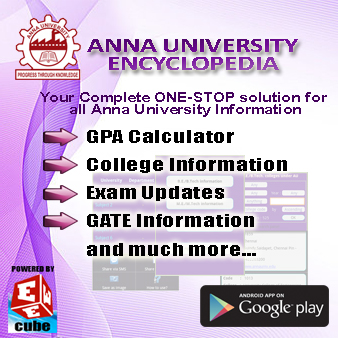SUBJECT RESOURCES:
CLICK HERE to access 'Question Banks'
CLICK HERE to search more about this subject
SYLLABUS:
CLICK HERE to access 'Question Banks'
CLICK HERE to search more about this subject
SYLLABUS:
EI2403 VLSI DESIGN L T P C
3 0 0 3
AIM
To
understand the basic concepts of VLSI and CMOS design.
OBJECTIVES
· To
give clear
idea about the basics of VLSI design and its importance.
· To know about the operating principles of MOS transistor.
· To study about construction of NMOS, CMOS and Bi-CMOS based logic gates.
· To understand the functioning of programmable and Reprogrammable devices.
· To learn about the programming
of Programmable
device using
Hardware description
Language.
,
UNIT I BASIC MOS TRANSISTOR 9
Enhancement mode & Depletion mode – Fabrication (NMOS, PMOS, CMOS, BiCMOS) Technology
– NMOS transistor current equation – second order
effects – MOS Transistor
Model.
UNIT II NMOS & CMOS INVERTER AND GATES 9
NMOS & CMOS inverter – Determination of pull up / pull down ratios – stick diagram – lambda
based rules – super
buffers – BiCMOS & steering logic.
UNIT III SUB SYSTEM DESIGN & LAYOUT 9
Structured design of combinational circuits – Dynamic CMOS &
clocking – Tally circuits – (NAND- NAND, NOR-NOR and AOI logic) – EXOR structure – Multiplexer
structures – Barrel shifter.
UNIT IV DESIGN OF COMBINATIONAL ELEMENTS & REGULAR ARRAYLOGIC 9
NMOS PLA – Programmable Logic Devices - Finite State Machine PLA – Introduction to FPGA,
CPLD.
UNIT V VHDL PROGRAMMING 9
RTL Design – Detructured level Design -combinational logic – Types – Operators – Packages – Sequential circuit – Sub programs
– Test benches. (Examples:
address, counters, flipflops, FSM, Multiplexers / Demltiplexers).
TOTAL : 45 PERIODS
TEXT BOOKS
1. D.A.Pucknell, K.Eshraghian, ‘Basic VLSI Design’, 3rd Edition, Prentice Hall of India, New
Delhi, 2003.
2. Eugene D.Fabricius, ‘Introduction to VLSI Design’, Tata McGraw Hill, 1990.
REFERENCES
1. N.H.Weste, ‘Principles of CMOS VLSI Design’, Pearson Education, India, 2002.
2. Charles H.Roth, ‘Fundamentals of Logic Design’, Jaico Publishing House, 1992.
3. Zainalatsedin Navabi, ‘VHDL Analysis and Modelling of Digital Systems’, 2n
Edition, Tata McGraw Hill, 1998.
4. Douglas Perry, ‘VHDL Programming By Example’, Tata McGraw Hill, 3rdEdition.2007.
5. Parag K.Lala, ‘Digitl System Design using PLD’, BS Publications, 2003.
|
|










No comments:
Post a Comment
Note: Only a member of this blog may post a comment.